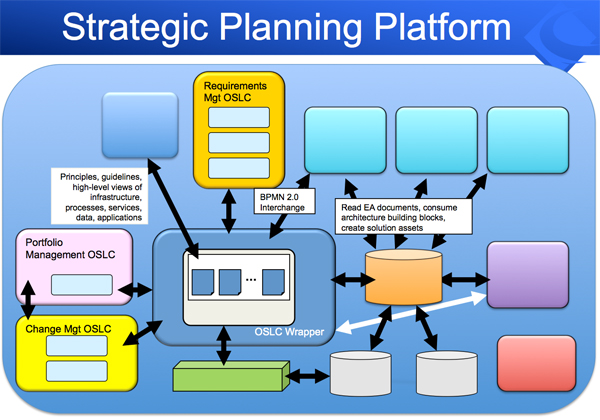Enterprise architecture (EA) can be seen in a couple of ways. Some see it as the ivory tower, the blueprint to which all users must adhere, unfailingly and without question. Even Martin Owen, who has been involved with enterprise architecture for a long while, admitted, “EA on its own has no value, unless you plug it into stakeholders in the right way.”
Another, perhaps better way to see EA is as the one source of truth for the business and IT, enabling product and portfolio management, requirements gathering and management, and prioritization of projects, as well as other management tasks critical to the software development life cycle.
“EA was seen as an IT function, but it’s not just that,” said Owen, who spent time with architecture software company Popkin Software and Telelogic before moving on to IBM and now serving as CEO for IBM partner Corso, a consulting firm. “One of the age-old problems of enterprise architecture is showing the value of it. EA is becoming more aligned with the program management office and the business,” he said.
Corso in the next few months will launch a cloud-based version of its EA software, the Strategic Planning Platform, which clearly demonstrates the business value of EA. “It’s broadening the scope of EA to include portfolio management, and also looking at transition planning, reducing business initiatives, and project plans based on ideas and requirements within an organization,” said Owen.
He pointed out that organizations today have disparate sources of information. “We’ve got a lot of organizations doing lots of things around social media, and using it to have collaboration, certainly about thoughts threads and ideas. And then we’ve got other companies doing portfolio management…doing things like managing the project portfolio, timesheets and resource planning. Then there’s the EA community. We’re trying to bring those together. Let’s bring that together with the idea of prioritization and managing that as a portfolio, and mapping into the EA to get the one source of truth and then moving forward with very accurate project plans based on market needs and/or user needs, and feeding it all back through again. It’s a life cycle of strategic planning.”
In its first iteration of the Strategic Planning Platform, Corso is using IBM tooling, Owen said, including IBM Rational Focal Point for portfolio management, System Architect for the EA portion, and Composer, Requisite Pro or DOORS for requirements management.
“We’ve managed to get agreements to provide the software on a monthly basis, which is different from how IBM traditionally sells its software,” he said. “It’s definitely more accessible. This will front-end things like agile development and solution architectures.”
Requirements can be fed right to the top of the solution funnel, so that in an agile development shop, the workstreams “are all projects that should have derived value directly from the [Strategic Planning Platform],” said Owen.

He further explained that a business-intelligence layer runs through the platform, though it’s not focused on financials. “It’s how we ask certain questions of the [Strategic Planning Platform]. Typically, questions might be like, ‘Show me all the high-value customers that are affected by this project, which is overrunning.’ We harvest the data from something like Salesforce.com and map it back to the EA, into projects and the portfolio, and then you can ask really really good questions.”
Underpinning the platform is Rational Team Concert for change and configuration management, which Owen said is used to “manage transition plans in the EA.” Team Concert is built on IBM’s Jazz technology, and it supports the Open Services for Lifecycle Collaboration specification. OSLC allows object linking via an exposed API that carries the context of what the object is for the tool or tools that need to use it, so the object can be integrated into a web of data, eliminating point-to-point connection, Owen explained.
Because Corso’s planning platform supports OSLC, the company is looking to integrate multiple BPM and EA tools, along with the tools’ data and workflows. Meanwhile, Jazz provides the platform backbone for single sign-on, authentication and reporting.






